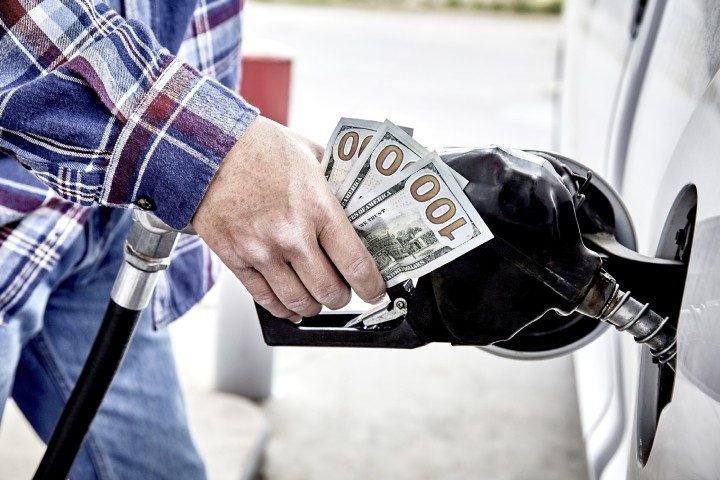
Joe Biden’s incendiary letter to the head of the Federal Trade Commission (FTC) accused oil companies ExxonMobil and Chevron of profiting at the expense of the average American who has seen gas prices at the pump jump 60 percent over the last year.
In response, both oil industry trade groups — the American Petroleum Institute (API) and the American Fuel & Petrochemical Manufacturers (AFPM) — blamed Biden.
Both are wrong. The people running the printing press are to blame.
Whomever wrote the letter that Biden signed and sent on Wednesday said the bottom line is this: “Gasoline prices at the pump remain high, even though oil and gas companies’ costs are declining.”
Even worse, they’re profiting at drivers’ expense:
In the last month, the price of unfinished [wholesale] gasoline is down more than 5 percent while gas prices at the pump are up 3 percent in that same period….
Meanwhile, the largest oil and gas companies in American [ExxonMobil and Chevron are the two largest] are generating significant profits off higher energy prices….
The letter ended with the threat:
I do not accept hard-working Americans paying more for gas because of anti-competitive or otherwise potentially illegal conduct.
I therefore ask that … you bring all of the Commission’s tools to bear if you uncover any wrongdoing.
The spokesman for the American Petroleum Institute got it partially right when he called the Biden letter “a distraction.” That is the usual tool politicians use when they want to deflect attention away from themselves and their destructive policies. In the instant case, the target is the oil industry — those big, bad, dirty, polluting, selfish and, as a result, highly profitable companies. The same companies that have provided gas at competitive rates to American motorists for decades.
The API spokesman got it wrong when he blamed “the ill-advised government decisions that are exacerbating this challenging situation.”
The spokesman for the AFPM also blamed government policy:
Federal policy is discouraging supply by shutting down pipelines, putting future production off limits, talking down the future of the petroleum business, and imposing expensive requirements on refineries….
The administration is blaming others when it ought to take a sober look at its own energy policy.
If gas prices were the only commodity going up 60 percent in a year, then perhaps Biden and the FTC might have a case. Something fishy would be going on.
And because a barrel of oil is used for more than 6,000 products (from umbrellas to bicycle tires, from shampoo to house paint), when the price of a barrel goes up, so do the prices of those products. To a consumer of those products, it looks like oil is the prime, or even the only, driver of those price increases.
But it’s not. Everywhere else one looks, prices are going up, not only at the pump but at the grocery store, home improvement centers, and big box retailers. Overall, the Consumer Price Index (CPI), a faulty but still often-used measure of inflation, is up more than six percent in a year.
Something else is going on, and free market economist Milton Friedman nailed it: “Inflation is always and everywhere a monetary phenomenon.”
And who is in charge of that “monetary phenomenon”? The Federal Reserve. As it purchases government bonds from the federal government it increases the supply of money in circulation, and rising prices follow.
According to the Fed (which isn’t shy about revealing what it’s doing), the amount of money in the U.S. economy has grown at nearly a 20 percent annual rate. If that’s so, then consumers should be happy that their cost of living is only up six percent! It could be much worse!
Here’s how the printing press at the Fed works: The U.S. Treasury sell bonds to the Federal Reserve which pays for them by putting new digital currency into its checking account. The government then pays its bills with the new money. That way politicians can pay for spending without raising taxes or borrowing. Instead, the tool they use is far more insidious and difficult for the average consumer to fathom: the new spending is paid for by the loss in the purchasing power of their dollars.
As former Fed Chairman Alan Greenspan explained:
The abandonment of the gold standard made it possible for the welfare statists to use the banking system as a means to an unlimited expansion of credit. They have created paper reserves in the form of government bonds which — through a complex series of steps — the banks accept in place of tangible assets and treat as if they were an actual deposit, i.e., as the equivalent of what was formerly a deposit of gold….
The law of supply and demand is not to be conned. As the supply of money … increases relative to the supply of tangible assets in the economy, prices must eventually rise.
Thus the earnings saved by the productive members of the society lose value in terms of goods….
In the absence of the gold standard, there is no way to protect savings from confiscation through inflation. There is no safe store of value. If there were, the government would have to make its holding illegal, as was done in the case of gold.
This is the shabby secret of the welfare statists’ tirades against gold. Deficit spending is simply a scheme for the confiscation of wealth.
For the record, Greenspan was in charge of this “scheme for the confiscation of wealth” as chairman of the Federal Reserve, serving five terms from 1987 to 2006.
Don’t pay attention to those distractions or deflections away from the principal cause of rising gas prices. It’s the Fed. It’s always the Fed.



